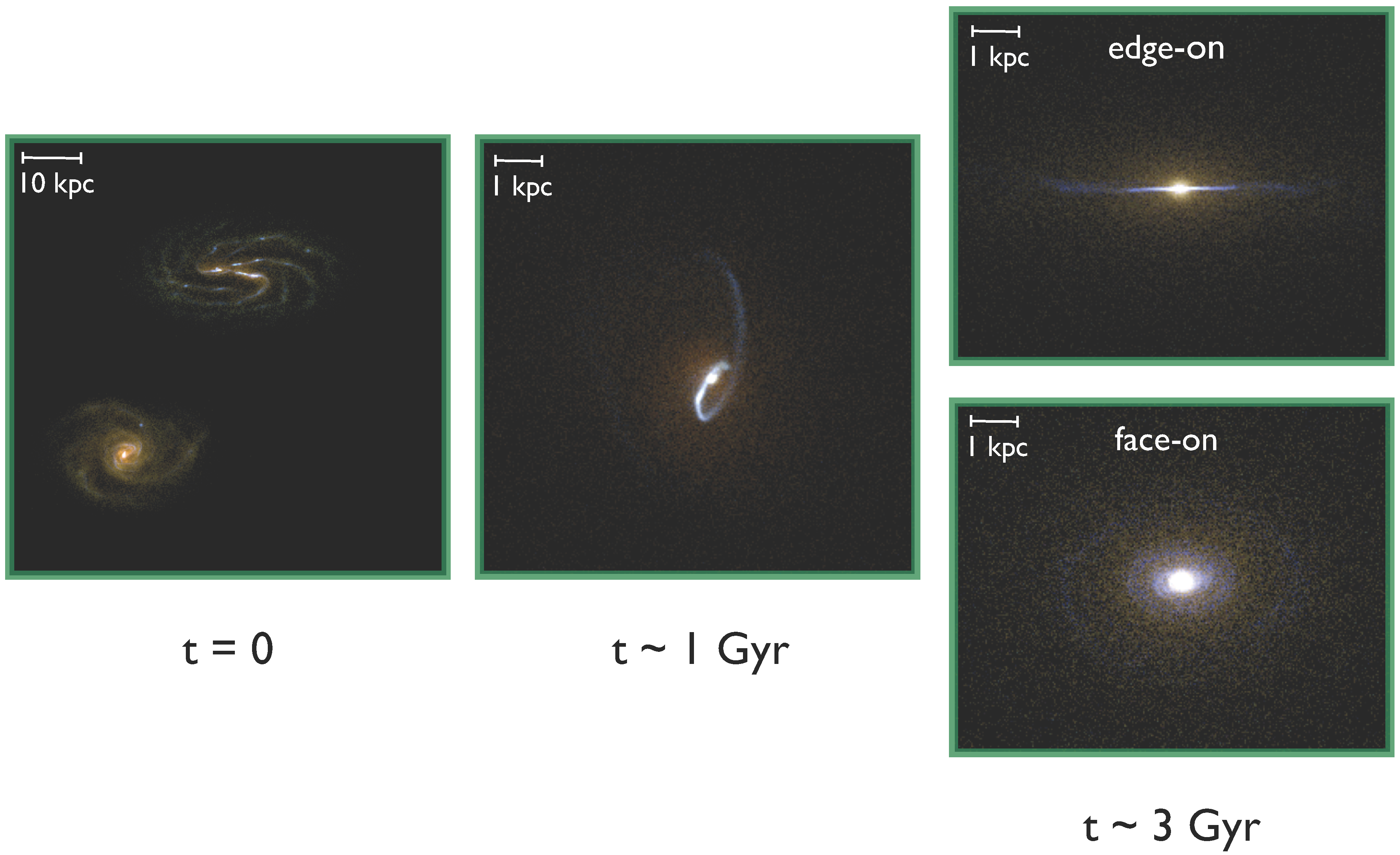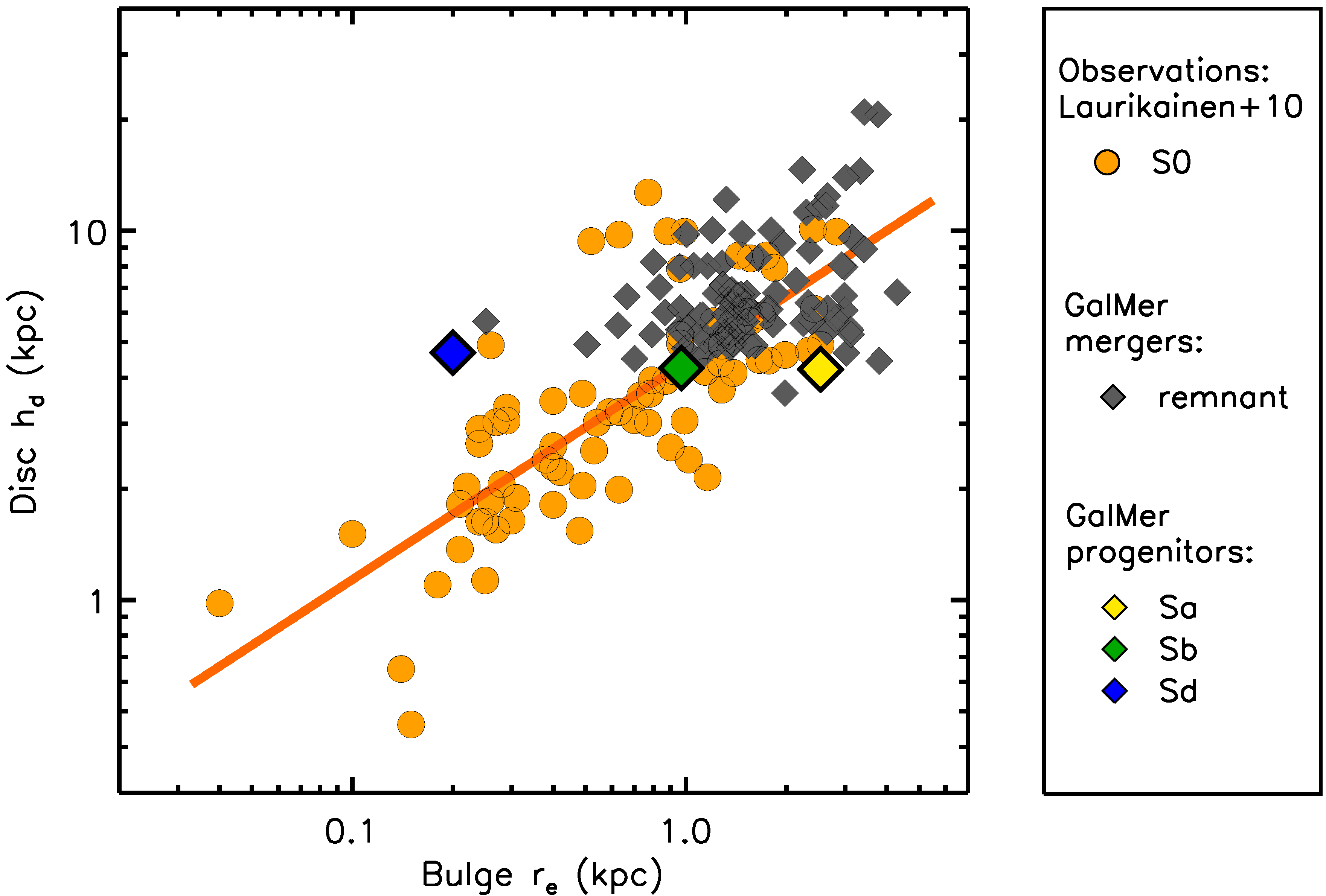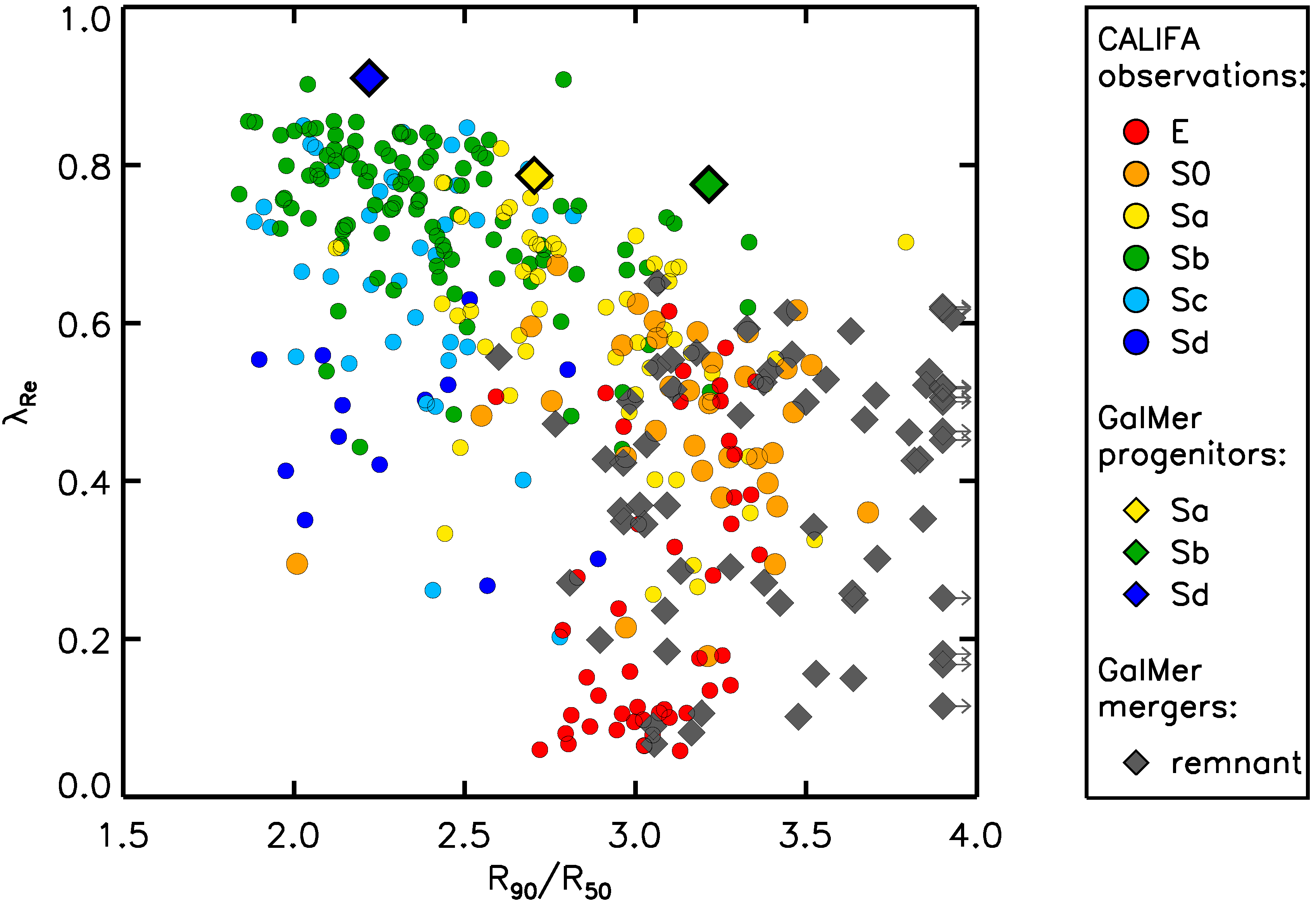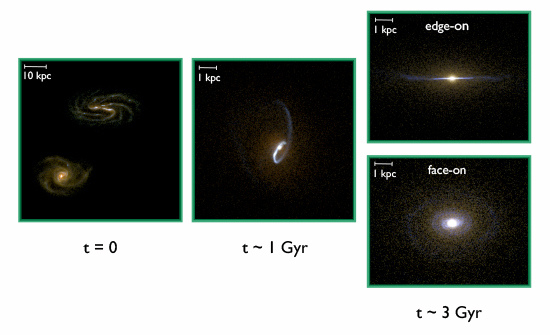Creating S0s with Major Mergers: A 3D View
Abstract
:1. Introduction
2. Creating Lenticulars With Major Mergers: Photometry
2.1. Simulations of Major Mergers and Mock Images
2.2. Results on Photometric Scaling Relations


3. Creating Lenticulars with Major Mergers: Kinematics

4. Concluding Remarks
Acknowledgments
Author Contributions
Conflicts of Interest
References
- Querejeta, M.; Eliche-Moral, M.C.; Tapia, T.; Borlaff, A.; Rodríguez-Pérez, C.; Zamorano, J.; Gallego, J. Formation of S0 galaxies through mergers. Bulge-disc structural coupling resulting from major mergers. Astron. Astrophys. 2015, 573, A78. [Google Scholar] [CrossRef]
- Querejeta, M.; Eliche-Moral, M.C.; Tapia, T.; Borlaff, A.; van de Ven, G.; Lyubenova, M.; Martig, M.; Falcón-Barroso, J.; Méndez-Abreu, J. Formation of S0 galaxies through mergers. Explaining angular momentum and concentration change from spirals to S0s. Astron. Astrophys. 2015, 579, L2. [Google Scholar] [CrossRef]
- Hubble, E.P. Realm of the Nebulae; Yale University Press: New Haven, CT, USA, 1936. [Google Scholar]
- De Vaucouleurs, G.; De Vaucouleurs, A.; Corwin, H.G., Jr.; Buta, R.J.; Paturel, G.; Fouqué, P. Third Reference Catalogue of Bright Galaxies. Volume I: Explanations and references. Volume II: Data for galaxies between 0h and 12h. Volume III: Data for galaxies between 12h and 24h; Springer: New York, NY, USA, 1991. [Google Scholar]
- Laurikainen, E.; Salo, H.; Buta, R.; Knapen, J.H.; Comerón, S. Photometric scaling relations of lenticular and spiral galaxies. Mon. Not. R. Astron. Soc. 2010, 405, 1089–1118. [Google Scholar] [CrossRef]
- Cappellari, M.; Emsellem, E.; Krajnović, D.; McDermid, R.M.; Serra, P.; Alatalo, K.; Blitz, L.; Bois, M.; Bournaud, F.; Bureau, M.; et al. The ATLAS3D project—VII. A new look at the morphology of nearby galaxies: The kinematic morphology-density relation. Mon. Not. R. Astron. Soc. 2011, 416, 1680–1696. [Google Scholar] [CrossRef]
- Kormendy, J.; Bender, R. A Revised Parallel-sequence Morphological Classification of Galaxies: Structure and Formation of S0 and Spheroidal Galaxies. Astrophys. J. Suppl. 2012, 198, 2. [Google Scholar] [CrossRef]
- Crowl, H.H.; Kenney, J.D.P.; van Gorkom, J.H.; Vollmer, B. Dense Cloud Ablation and Ram Pressure Stripping of the Virgo Spiral NGC 4402. Astron. J. 2005, 130, 65–72. [Google Scholar] [CrossRef]
- Aragón-Salamanca, A.; Bedregal, A.G.; Merrifield, M.R. Measuring the fading of S0 galaxies using globular clusters. Astron. Astrophys. 2006, 458, 101–105. [Google Scholar] [CrossRef]
- Crowl, H.H.; Kenney, J.D.P. The Stellar Populations of Stripped Spiral Galaxies in the Virgo Cluster. Astron. J. 2008, 136, 1623–1644. [Google Scholar] [CrossRef]
- Maltby, D.T.; Aragón-Salamanca, A.; Gray, M.E.; Hoyos, C.; Wolf, C.; Jogee, S.; Böhm, A. The environmental dependence of the structure of galactic discs in STAGES S0 galaxies: Implications for S0 formation. Mon. Not. R. Astron. Soc. 2015, 447, 1506–1530. [Google Scholar] [CrossRef]
- Dressler, A. Galaxy morphology in rich clusters—Implications for the formation and evolution of galaxies. Astrophys. J. 1980, 236, 351–365. [Google Scholar] [CrossRef]
- Wilman, D.J.; Oemler, A., Jr.; Mulchaey, J.S.; McGee, S.L.; Balogh, M.L.; Bower, R.G. Morphological Composition of z 0.4 Groups: The Site of S0 Formation. Astrophys. J. 2009, 692, 298–308. [Google Scholar] [CrossRef]
- Bekki, K.; Couch, W.J. Transformation from spirals into S0s with bulge growth in groups of galaxies. Mon. Not. R. Astron. Soc. 2011, 415, 1783–1796. [Google Scholar] [CrossRef]
- Mazzei, P.; Marino, A.; Rampazzo, R. The NUV-r versus Mr Plane as a Tracer of Early-type Galaxy Evolution in the USGC U376 and LGG 225 Groups. Astrophys. J. 2014, 782, 53. [Google Scholar] [CrossRef]
- Mazzei, P.; Marino, A.; Rampazzo, R.; Galletta, G.; Bettoni, D. Catching spiral - S0 transition in groups. Insights from SPH simulations with chemo-photometric implementation. Adv. Space Res. 2014, 53, 950–962. [Google Scholar] [CrossRef]
- Springel, V.; Hernquist, L. Formation of a Spiral Galaxy in a Major Merger. Astrophys. J. Lett. 2005, 622, L9–L12. [Google Scholar] [CrossRef]
- Hopkins, P.F.; Cox, T.J.; Younger, J.D.; Hernquist, L. How do Disks Survive Mergers? Astrophys. J. 2009, 691, 1168–1201. [Google Scholar] [CrossRef]
- Chilingarian, I.V.; di Matteo, P.; Combes, F.; Melchior, A.L.; Semelin, B. The GalMer database: Galaxy mergers in the virtual observatory. Astron. Astrophys. 2010, 518, A61. [Google Scholar] [CrossRef]
- Bruzual, G.; Charlot, S. Stellar population synthesis at the resolution of 2003. Mon. Not. R. Astron. Soc. 2003, 344, 1000–1028. [Google Scholar] [CrossRef]
- Falcón-Barroso, J.; Lyubenova, M.; Van de Ven, G. Angular Momentum Across the Hubble Sequence From the CALIFA Survey. In IAU Symposium S311: Galaxy Masses as Constraints of Formation Models; Cappellari, M., Courteau, S., Eds.; Cambridge University Press: Cambridge, UK, 2015; pp. 78–81. [Google Scholar]
- Emsellem, E.; Cappellari, M.; Krajnović, D.; Alatalo, K.; Blitz, L.; Bois, M.; Bournaud, F.; Bureau, M.; Davies, R.L.; Davis, T.A.; et al. The ATLAS3D project - III. A census of the stellar angular momentum within the effective radius of early-type galaxies: Unveiling the distribution of fast and slow rotators. Mon. Not. R. Astron. Soc. 2011, 414, 888–912. [Google Scholar] [CrossRef]
- Barnes, J.E.; Hernquist, L.E. Fueling starburst galaxies with gas-rich mergers. Astrophys. J. Lett. 1991, 370, L65–L68. [Google Scholar] [CrossRef]
- Graham, A.W.; Worley, C.C. Inclination- and dust-corrected galaxy parameters: Bulge-to-disc ratios and size-luminosity relations. Mon. Not. R. Astron. Soc. 2008, 388, 1708–1728. [Google Scholar] [CrossRef]
- Barnes, J.E. Formation of gas discs in merging galaxies. Mon. Not. R. Astron. Soc. 2002, 333, 481–494. [Google Scholar] [CrossRef]
- Robertson, B.; Yoshida, N.; Springel, V.; Hernquist, L. Disk Galaxy Formation in a Λ Cold Dark Matter Universe. Astrophys. J. 2004, 606, 32–45. [Google Scholar] [CrossRef]
- Robertson, B.; Bullock, J.S.; Cox, T.J.; Di Matteo, T.; Hernquist, L.; Springel, V.; Yoshida, N. A Merger-driven Scenario for Cosmological Disk Galaxy Formation. Astrophys. J. 2006, 645, 986–1000. [Google Scholar] [CrossRef]
- Moster, B.P.; Macciò, A.V.; Somerville, R.S.; Naab, T.; Cox, T.J. The effects of a hot gaseous halo in galaxy major mergers. Mon. Not. R. Astron. Soc. 2011, 415, 3750–3770. [Google Scholar] [CrossRef]
- Bournaud, F.; Chapon, D.; Teyssier, R.; Powell, L.C.; Elmegreen, B.G.; Elmegreen, D.M.; Duc, P.A.; Contini, T.; Epinat, B.; Shapiro, K.L. Hydrodynamics of High-redshift Galaxy Collisions: From Gas-rich Disks to Dispersion-dominated Mergers and Compact Spheroids. Astrophys. J. 2011, 730, 4. [Google Scholar] [CrossRef]
- Borlaff, A.; Eliche-Moral, M.C.; Rodríguez-Pérez, C.; Querejeta, M.; Tapia, T.; Pérez-González, P.G.; Zamorano, J.; Gallego, J.; Beckman, J. Formation of S0 galaxies through mergers. Antitruncated stellar discs resulting from major mergers. Astron. Astrophys. 2014, 570, A103. [Google Scholar] [CrossRef]
- Moore, B.; Katz, N.; Lake, G.; Dressler, A.; Oemler, A. Galaxy harassment and the evolution of clusters of galaxies. Nature 1996, 379, 613–616. [Google Scholar] [CrossRef]
- Shaya, E.J.; Tully, R.B. The angular momentum content of galaxies. Astrophys. J. 1984, 281, 56–66. [Google Scholar] [CrossRef]
- Head, J.T.C.G.; Lucey, J.R.; Hudson, M.J.; Smith, R.J. Dissecting the red sequence: The bulge and disc colours of early-type galaxies in the Coma cluster. Mon. Not. R. Astron. Soc. 2014, 440, 1690–1711. [Google Scholar] [CrossRef]
- Sil’chenko, O.K.; Proshina, I.S.; Shulga, A.P.; Koposov, S.E. Ages and abundances in large-scale stellar discs of nearby S0 galaxies. Mon. Not. R. Astron. Soc. 2012, 427, 790–805. [Google Scholar] [CrossRef]
- Katkov, I.Y.; Kniazev, A.Y.; Sil’chenko, O.K. Kinematics and Stellar Populations in Isolated Lenticular Galaxies. Astron. J. 2015, 150, 24. [Google Scholar] [CrossRef]
© 2015 by the authors; licensee MDPI, Basel, Switzerland. This article is an open access article distributed under the terms and conditions of the Creative Commons Attribution license (http://creativecommons.org/licenses/by/4.0/).
Share and Cite
Querejeta, M.; Eliche-Moral, M.C.; Tapia, T.; Borlaff, A.; Van de Ven, G.; Lyubenova, M.; Martig, M.; Falcón-Barroso, J.; Méndez-Abreu, J.; Zamorano, J.; et al. Creating S0s with Major Mergers: A 3D View. Galaxies 2015, 3, 202-211. https://doi.org/10.3390/galaxies3040202
Querejeta M, Eliche-Moral MC, Tapia T, Borlaff A, Van de Ven G, Lyubenova M, Martig M, Falcón-Barroso J, Méndez-Abreu J, Zamorano J, et al. Creating S0s with Major Mergers: A 3D View. Galaxies. 2015; 3(4):202-211. https://doi.org/10.3390/galaxies3040202
Chicago/Turabian StyleQuerejeta, Miguel, M. Carmen Eliche-Moral, Trinidad Tapia, Alejandro Borlaff, Glenn Van de Ven, Mariya Lyubenova, Marie Martig, Jesús Falcón-Barroso, Jairo Méndez-Abreu, Jaime Zamorano, and et al. 2015. "Creating S0s with Major Mergers: A 3D View" Galaxies 3, no. 4: 202-211. https://doi.org/10.3390/galaxies3040202






